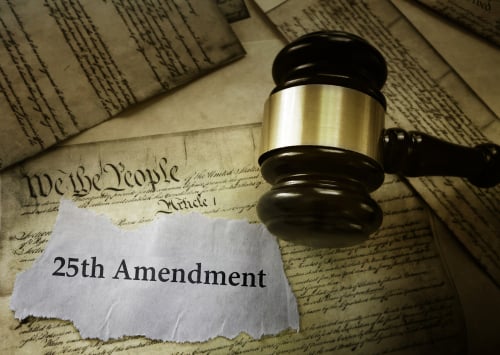Calls mount to use 25th Amendment to remove Trump; how would it work?

Image from Shutterstock.com.
After a mob stormed the U.S. Capitol on Wednesday, House Judiciary Democrats asked Vice President Mike Pence to invoke the 25th Amendment to remove President Donald Trump from office. A Republican congressman from Illinois also backed the effort.
Democrats on the House Judiciary Committee made the request in a letter to Pence on Wednesday, report the Hill, the New York Times and Axios.
“For the sake of our democracy,” the letter said, “we emphatically urge you to invoke the 25th Amendment and begin the process of removing President Trump from power. President Trump has shown time and again that he is unwilling to protect our democracy and carry out the duties of the office.”
U.S. Rep. Adam Kinzinger of Illinois became the first Republican congressman to call for Trump’s removal via the 25th Amendment, according to an NPR tweet.
“It’s with a heavy heart I am calling for the sake of our Democracy that the 25th Amendment be invoked,” he said on Twitter.
“All indications are that the president has become unmoored, not just from his duty or even his oath but from reality,” he said in his Twitter video.
House Speaker Nancy Pelosi and Senate Minority Leader Chuck Schumer are also asking Pence to invoke the 25th Amendment, Politico reports.
The pro-Trump rioting followed Trump’s address early Wednesday in which he asked supporters to march to the Capitol and asserted that the country was being destroyed by a stolen election. After the assault on the Capitol, Trump posted a video message on Twitter urging his supporters to go home, even as he continued to claim that he had won the election. Twitter subsequently deleted the video and said it violated its rules.
Also calling for use of the amendment was Jay Timmons, president and CEO of the National Association of Manufacturers, who argued that Trump had incited the violence to stay in power, and it amounts to sedition.
The 25th Amendment creates a mechanism to determine when a president is incapacitated, which would permit the vice president to assume the duties of president. The amendment was in the news when Trump revealed that he had COVID-19, and it’s getting a new look by publications such as USA Today and Vox.
Section 4 of the amendment—which has never been used—applies when a president is “unable to discharge the powers and duties of his office.”
Under the amendment, the vice president immediately takes over after he and a majority of Cabinet secretaries or a group appointed by Congress inform congressional officials that that the president is incapacitated. The officials who must be informed are the House speaker and the president pro tempore of the Senate.
The amendment isn’t clear about what constitutes an inability to serve, according to USA Today.
A president can dispute the incapacity determination and resume his duties—unless there is an objection within four days by the vice president and a majority of the officials who declared the president incapacitated. At that point, Congress decides the issue, with a two-thirds vote of both chambers required to prevent the president from resuming control.
Congress has 21 days to act, which means lawmakers could avoid a vote before Trump leaves office Jan. 20, Vox points out.
In a New York Times op-ed, two law professors urged Pence and the Cabinet to invoke Section 4. The result would be an immediate suspension of Trump, which would allow time for an impeachment effort.
The op-ed also argued that Congress should proceed with impeachment, even if Trump has already left office. The authors were law professors David Landau of Florida State University and Rosalind Dixon of UNSW Sydney in Australia, a recent visiting professor at Harvard Law School.
Updated Jan. 7 at 1:45 p.m. to include info from Pelosi and Schumer.



